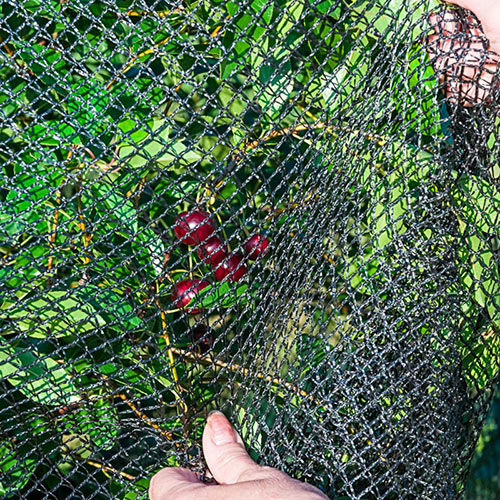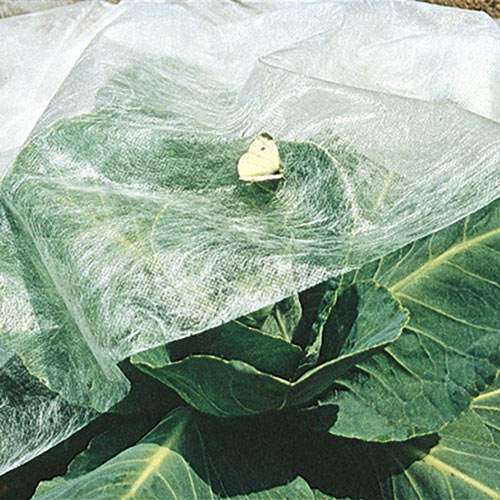Here Come the Cicadas! (or su-kad-ahs if you're British)
-
Helpful Products from Gardens Alive!
-
 Premium Bird Nettings - Plant Protection
Premium Bird Nettings - Plant Protection -
 Super-Lite Insect Barrier - Lightweight Row Cover
Super-Lite Insect Barrier - Lightweight Row Cover
2024 is a banner year for The World's Most Unusual Insects. Every summer we are treated to the emergence and subsequent serenade and bug-eyed scariness of ANNUAL cicadas; which, as the name more than implies, appear every year around the same time (unless someone cut down the trees they were living under and paved the area, then those ones are out of luck).
Periodic cicadas are another story. Individual colonies are classified (using Roman numerals) as 'broods', and there are two main types. Brood number 19 emerges every 13 years, while the ('sleeping-in') brood (Roman numeral 13) emerges once every 17 years. This year, those two big broods will emerge at the same time, with total numbers in the trillions. Many of you have some noisy summer nights ahead.
(Annual cicadas will also be out and about this summer.)
Note: The Brood numbers do not change over the years; they are and will remain the official way to identify a specific brood. The overall species name for most periodics is Magicicada, a combination of the words 'Magic' and 'cicada'.
Ma-ja-say-duh (fast)
According to the University of Connecticut's 2024 map, this year's emergence is going to be mostly a Southern and midwestern event: South from around Milwaukee to Kansas (which appears to be ground zero) and Arkansas, then taking a dogleg East to cover most of Georgia, Alabama and the Carolinas. Then it takes a break and pops up from Norfolk to Washington, DC. (Your state extension website will have very specific maps for your region.)
What does this sudden appearance of trillions of weird looking, buzzing, red-eyed insects mean to you? Plenty if you have young trees. Here's the life cycle: After semi-hibernating for thirteen or seventeen years slowly sucking on the roots of plants, the larval forms have gone through several 'molts', gaining size every time. Then, at the gong of an invisible bell, the next-to-last molt will emerge aboveground, looking kind of like a cicada, but white (so, no, you did not discover a rare albino cicada.)
They climb up on a surface and go through a final molt, leaving their extremely creepy exoskeletons behind on trees, cars, walls--wherever and everywhere. They need to dry their wings for a few days, then the males go in search of females and mate. This is when your young trees are in danger. After mating, the females cut slits in tree branches in which to lay their 600 or so eggs. They don't eat the branches, but the cutting damage can be severe, especially when there are so many of them.
Forget about spraying; the cicadas are not vulnerable, there are just too many of them, and you'd be harming the birds, toads, and other predators like the famed cicada killing wasp that feast on this huge buffet.
One solution is to cover young trees--especially fruit trees--with insect netting, like a lightweight row cover, until the invasion is over. (The labels on some barrier products will even be cicada-specific). Others recommend coating young branches with peppermint oil to repel the females. The Morton Arboretum in Illinois (an area due to host lots of cicadas this summer) adds the suggestion not to plant new trees this Spring. Leave them out in pots until you hear buzzing and cover them with netting or move them to a safe spot indoors. The attack will only last a few weeks.
Fall is a much better time to plant trees than Spring anyway. If you're just now thinking about planting new trees this year, you're in luck. Delay buying and planting the trees until the end of summer and/or you no longer notice the outdoor racket.
Scientific interest is high for the 2024 event, with several scholarly books, tons of magazine, newspaper and journal articles commemorating the event, plus a new graphic novel aimed at kids called Cicadapocalypse in which we apparently witness the event through the eyes of some startled squirrels.
These periodic emergences were first described (in Philadelphia, of course) in the 1700s. Following that, naturalists like Jefferson and Franklin started keeping track of the {quote} "American Locust" emergence years. (Thankfully, cicadas have no actual connection with true locusts, a form of grasshopper whose huge swarms decimate crop lands and anything else they can eat.)
Native to mostly Eastern and mid-West North America from Canada on down, all of the cicada broods do NOT emerge in the same year. (That would be extremely unsettling.) That's why they name those broods, so entomologists can predict the areas of emergence from year to year, which gives farmers and gardeners time to prepare. My home state of Pennsylvania has seen some monster broods emerge over the last few centuries, but the entomologists predict that I won't encounter a single periodic this year; just a smattering of the every year annuals.
The emergence time is mid-to-late April in warm climes to June in chilly ones. That means it is now time to prepare--especially in regions where the emergence will be so dense you can't read the state name on the overlay map. (That's you Kansas, Missouri and Iowa.)
And no, they don't bite, sting or otherwise harm humans. Their only defense against predators is their sheer numbers.
https://cicadas.uconn.edu/general_information/
Periodic cicadas are another story. Individual colonies are classified (using Roman numerals) as 'broods', and there are two main types. Brood number 19 emerges every 13 years, while the ('sleeping-in') brood (Roman numeral 13) emerges once every 17 years. This year, those two big broods will emerge at the same time, with total numbers in the trillions. Many of you have some noisy summer nights ahead.
(Annual cicadas will also be out and about this summer.)
Note: The Brood numbers do not change over the years; they are and will remain the official way to identify a specific brood. The overall species name for most periodics is Magicicada, a combination of the words 'Magic' and 'cicada'.
Ma-ja-say-duh (fast)
According to the University of Connecticut's 2024 map, this year's emergence is going to be mostly a Southern and midwestern event: South from around Milwaukee to Kansas (which appears to be ground zero) and Arkansas, then taking a dogleg East to cover most of Georgia, Alabama and the Carolinas. Then it takes a break and pops up from Norfolk to Washington, DC. (Your state extension website will have very specific maps for your region.)
What does this sudden appearance of trillions of weird looking, buzzing, red-eyed insects mean to you? Plenty if you have young trees. Here's the life cycle: After semi-hibernating for thirteen or seventeen years slowly sucking on the roots of plants, the larval forms have gone through several 'molts', gaining size every time. Then, at the gong of an invisible bell, the next-to-last molt will emerge aboveground, looking kind of like a cicada, but white (so, no, you did not discover a rare albino cicada.)
They climb up on a surface and go through a final molt, leaving their extremely creepy exoskeletons behind on trees, cars, walls--wherever and everywhere. They need to dry their wings for a few days, then the males go in search of females and mate. This is when your young trees are in danger. After mating, the females cut slits in tree branches in which to lay their 600 or so eggs. They don't eat the branches, but the cutting damage can be severe, especially when there are so many of them.
Forget about spraying; the cicadas are not vulnerable, there are just too many of them, and you'd be harming the birds, toads, and other predators like the famed cicada killing wasp that feast on this huge buffet.
One solution is to cover young trees--especially fruit trees--with insect netting, like a lightweight row cover, until the invasion is over. (The labels on some barrier products will even be cicada-specific). Others recommend coating young branches with peppermint oil to repel the females. The Morton Arboretum in Illinois (an area due to host lots of cicadas this summer) adds the suggestion not to plant new trees this Spring. Leave them out in pots until you hear buzzing and cover them with netting or move them to a safe spot indoors. The attack will only last a few weeks.
Fall is a much better time to plant trees than Spring anyway. If you're just now thinking about planting new trees this year, you're in luck. Delay buying and planting the trees until the end of summer and/or you no longer notice the outdoor racket.
Scientific interest is high for the 2024 event, with several scholarly books, tons of magazine, newspaper and journal articles commemorating the event, plus a new graphic novel aimed at kids called Cicadapocalypse in which we apparently witness the event through the eyes of some startled squirrels.
These periodic emergences were first described (in Philadelphia, of course) in the 1700s. Following that, naturalists like Jefferson and Franklin started keeping track of the {quote} "American Locust" emergence years. (Thankfully, cicadas have no actual connection with true locusts, a form of grasshopper whose huge swarms decimate crop lands and anything else they can eat.)
Native to mostly Eastern and mid-West North America from Canada on down, all of the cicada broods do NOT emerge in the same year. (That would be extremely unsettling.) That's why they name those broods, so entomologists can predict the areas of emergence from year to year, which gives farmers and gardeners time to prepare. My home state of Pennsylvania has seen some monster broods emerge over the last few centuries, but the entomologists predict that I won't encounter a single periodic this year; just a smattering of the every year annuals.
The emergence time is mid-to-late April in warm climes to June in chilly ones. That means it is now time to prepare--especially in regions where the emergence will be so dense you can't read the state name on the overlay map. (That's you Kansas, Missouri and Iowa.)
And no, they don't bite, sting or otherwise harm humans. Their only defense against predators is their sheer numbers.
https://cicadas.uconn.edu/general_information/
-
Helpful Products from Gardens Alive!
-
 Premium Bird Nettings - Plant Protection
Premium Bird Nettings - Plant Protection -
 Super-Lite Insect Barrier - Lightweight Row Cover
Super-Lite Insect Barrier - Lightweight Row Cover







 Gardens Alive! & Supplies
Gardens Alive! & Supplies




